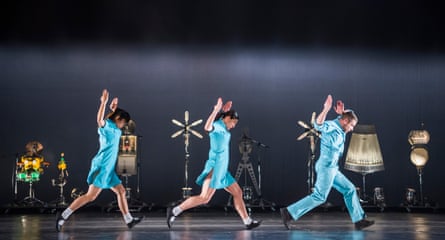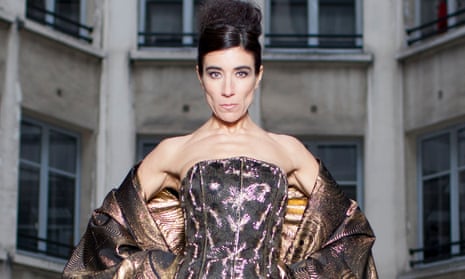I didn’t realise what a big deal Blanca Li was until she smuggled me into a Jean-Paul Gaultier show in Paris. We pulled up, stepped out of the car and hit a barrage of flashbulbs. “This way!” I heard hordes of snappers shout. “Over here!” Young women brandishing microphones rushed towards us for quotes, as the 53-year-old Li posed with dancerly elegance: small frame, wide smile and a hint of flamenco panache.
Inside, where Li had a front-row seat, famous photographers came over and showered her with air kisses. Catherine Deneuve stopped to say hello. Li, it seems, is not your ordinary choreographer. She is little-known in the UK: her company’s latest show, in which they dance with robots, marks only their second visit. But you have probably seen Li’s work before– in Daft Punk’s Around the World video, in the air steward dance routine in Pedro Almodóvar’s I’m So Excited, in Beyoncé’s Mrs Carter tour promos.
Then there’s the work she has done with Paul and Stella McCartney, Christian Louboutin, Coldplay, Michel Gondry and the Paris Opera. What’s more, as well as choreographing adverts and operas, Li writes, acts and has directed three feature films. Her latest, Elektro Mathematrix, a dialogue-free high school dance musical, was recently released in France.

Unsurprisingly, Li sits a little outside the conventional dance world. “I’ve never been in fashion,” she says, but the volume of her output is incredible. She never sticks to one dance style, flitting instead from classical to contemporary to all kinds of club dances. “Creativity is like a muscle,” she says. “The more you work it, the more ideas you have. I just can’t stop.”
She puts this drive down to her mother. Coming from a very traditional family in southern Spain, Li’s mum had seven kids before deciding she didn’t want to be just a housewife. So she set up an industrial cleaning company and went on to be one of Spain’s first female CEOs, while always having dinner on the table for her children.
Li would say she’s a product of her upbringing, and also of her time, growing up in Granada in the 1970s. “We came out of the Franco dictatorship and there was liberation. Young people became free and all of a sudden there was a lot of creativity, a lot of power, a lot of need to express yourself. So I think I was lucky. We thought we could do anything.”
That mantra certainly underlies Li’s career. As a child, she studied flamenco dance and ended up on Spain’s national rhythmic gymnastics team. “That was a very strong base for me. I learned to put my energy in the right place, to be efficient and to work – a lot.” Then, at 17, she went to New York to study modern dance with Martha Graham and Merce Cunningham, who showed her that she could create her own rules and technique.

While she was there, she happened to witness the birth of hip-hop, and her very first show, mounted in the East Village, featured classical, modern and hip-hop dancers. “It was very naïve,” she laughs. But she was hooked. “I got it in my veins. I found it so fantastic to make shows. From then on, I never stopped.” In New York she also met Etienne Li, a maths student and graffiti artist, who stencilled the flyers for that first performance. Thirty-five years later, they’re still together.
While in New York, Li and her sister started a pop group called Xoxonees, which means Little Pussies. Singing feminist flamenco-rap while wearing frou-frou Spanish dresses, they were like a cross between Blondie and Las Ketchup. To their astonishment, they were offered a record deal in Spain and put out a successful album. “We were kind of the first Spanish rap group,” she laughs.
Li moved to Paris knowing no one, and blagged a spot at a cabaret in Pigalle, dancing in a latex flamenco dress then donning a blonde wig to become Sara the MC, introducing singers, drag acts and circus performers. “It was a crazy atmosphere,” she says. “You didn’t know what would happen.” It soon had a huge cult following: Li does seem to have a knack for making things happen. “I like to party a lot,” she shrugs. “But for me the best parties are either where people dance a lot, or when people get the sensation of freedom through the people on stage.”
Dance has always been her true vocation, and she has been running her Paris-based company since 1993. The piece she has brought to Britain, Robot, is a response to technology’s ever-increasing presence in our lives. The dancers share the stage with actual robots, who play instruments and perform choreography Li has programmed for them.
Making it was a painstakingly slow process. “At some points,” she says, “I almost threw the whole project into the garbage, because it was impossible to get to the end of the show. There was always something wrong: the motor breaks, the battery’s low, they fall over, the wifi’s not working. One robot was dancing and his head fell off.” Robots don’t have the stamina of human dancers, it turns out. When they break down during the live performance, which they do, technicians simply come on stage to fix them while the dancers carry on.
For the project, Li went right back to the basic mechanics of movement, gravity and equilibrium – things that trained dancers take for granted. “Rediscovering the body as a machine,” she says. “And how perfect it is.” Robot, however, is no dystopian vision of a future ruled by AI: Li is excited and awed by the march of the machines, despite their potential effect on jobs.
It certainly seems unlikely that a robot could take over her job. “As an artist, I react to life every day. I react to where I was born, my family, my relationships, to art. Creation is a complex thing. I’m not sure creation, as we know it today, could be replaced by machines. But I think, in the future, creation will be more about interaction with machines.”
Although Li no longer dances in the works she makes for her own company, she does still love to get on stage. She has been performing a duet with Bolshoi ballerina Maria Alexandrova, a piece about women, power, femininity and mythology. “I can still dance flamenco, my body’s really strong,” she says. “But I’m getting older. Your body changes.” Then, with a glint in her eye, she adds: “I don’t mind if I cannot dance any more. I can still party.”
Robot is at the Barbican, London, until 25 February.

Comments (…)
Sign in or create your Guardian account to join the discussion